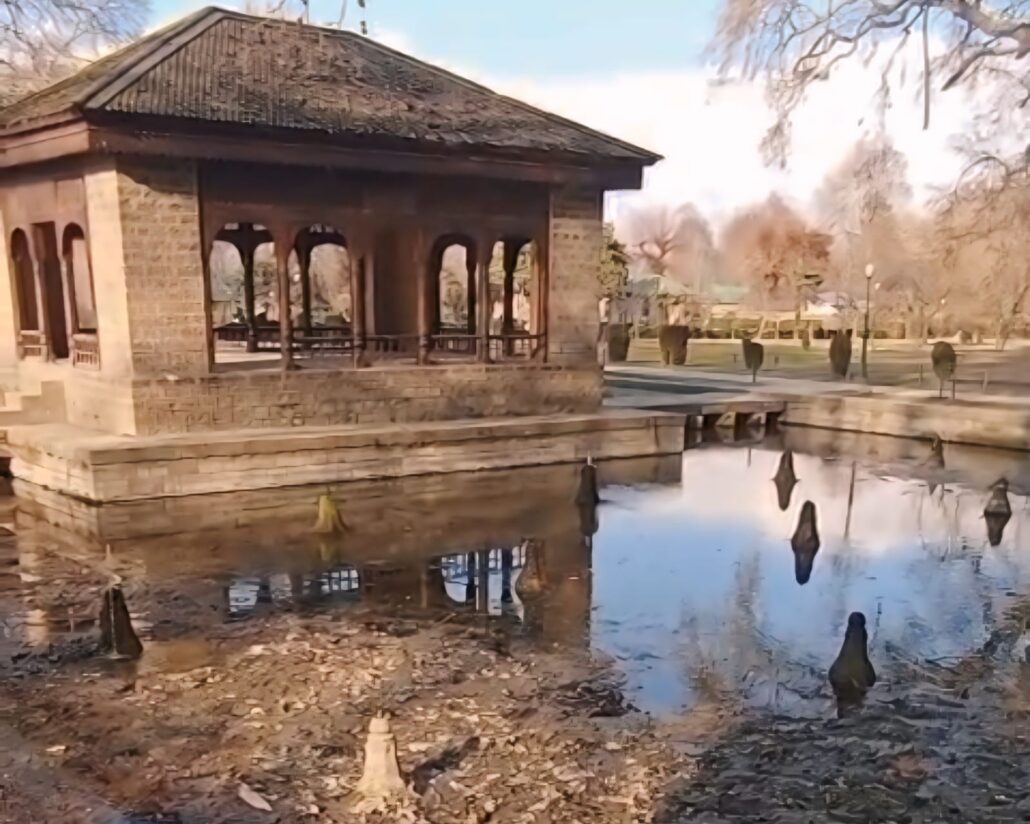
Sheikh Nadeem
On Saturday, the ancient stone fountains stood silent, their once vibrant streams reduced to empty basins. The lush Mughal-era gardens, usually nourished by the crystal-clear waters of Achabal Spring, lay parched under the February sun.
In a scene that locals could hardly believe, the historic spring in Anantnag district of Kashmir has gone completely dry. The barren pools and cracked earth are visible everywhere. For the first time in living memory, not a single drop flows from its source that has sustained generations of locals.
The residents told The Kashmiriyat on Saturday, (February 15, 2025), that while the spring has seen periods of low water before, it has never run completely dry. Ghulam Hassan, a 65-year-old local, expressing his disbelief said,
“Growing up here, this spring embodied life itself. Witnessing it fade feels like losing a part of our existence.”
Achabal Spring, originating from the base of the Anantnag hills, is historically linked as a tributary of the Bringi River.
The spring, known for its Mughal gardens built by Empress Nur Jahan in 1620, has long been a symbol of natural beauty and cultural heritage. Its waters are essential for irrigation and drinking purposes in the region.
The unprecedented drying of the spring is attributed to a combination of decreased precipitation, deforestation, and environmental degradation.
Kashmir has witnessed significantly low rainfall and snowfall in the last two years, leading to reduced groundwater recharge.
According to data from the Meteorological Department, the region recorded a 30 per cent decline in precipitation compared to the average of the past decade.
Environmental scientist Dr. Sameer Ahmad explained, “The ongoing dry spells and deforestation in the catchment areas have severely impacted our water reservoirs. Achabal Spring is not the only one suffering—other springs are also on the brink.”
This environmental crisis echoes across Kashmir, where several springs in Srinagar and Ganderbal have been closed due to contamination and diminishing water levels.
The unchecked pollution and environmental degradation have further endangered these natural water sources.
As the ancient fountains stand silent and the gardens dry up, the once-vibrant Achabal Spring now symbolizes the growing ecological challenges in Kashmir.
The locals watch in despair, hoping for the waters to return, yet fearing this may be a sign of an irreversible change.
Abdul Rahim, an elderly villager, looked at the barren spring and whispered,
“If our natural heritage perishes, what remains of us, and what hope is left for us? Will Kashmiris wake up before we lose everything that makes Kashmir?”
Author Profile

Latest entries
 REGIONALApril 3, 2025Waqf Amendment Bill: Here’s what parliamentarians from Jammu Kashmir said in Lok Sabha
REGIONALApril 3, 2025Waqf Amendment Bill: Here’s what parliamentarians from Jammu Kashmir said in Lok Sabha INDIAApril 3, 2025Political storm brews as JD(U) leaders resign over party’s support to Waqf Amendment Bill, more exits expected
INDIAApril 3, 2025Political storm brews as JD(U) leaders resign over party’s support to Waqf Amendment Bill, more exits expected REGIONALApril 3, 2025Cabinet expansion unlikely anytime soon in Jammu Kashmir
REGIONALApril 3, 2025Cabinet expansion unlikely anytime soon in Jammu Kashmir Representational ImageREGIONALApril 3, 2025Authorities shut alcohol shops illegally operating at Srinagar hotel
Representational ImageREGIONALApril 3, 2025Authorities shut alcohol shops illegally operating at Srinagar hotel
